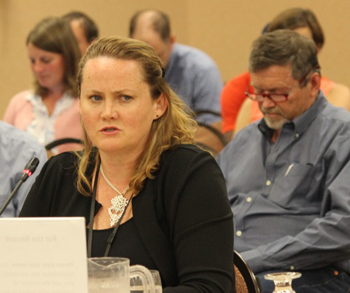Shutdown Delayed Federal Word on Herring Quota Cut
by Laurie Schreiber

Deirdre Boelke, NEFMC fishery analyst, Jan. 31 meeting. “Staff worked on the action during the shutdown, so it’s a little delayed but not as much as you might expect.” Boelke told NEFMC that a couple of scenarios were on the table. Fishermen’s Voice photo.
PORTSMOUTH, N.H.—As of late January, the New England Fishery Management Council (NEFMC) hadn’t yet heard from the National Marine Fisheries Service (NMFS) regarding steep cuts proposed for quotas in the Atlantic herring fishery.
The delay resulted from the federal government shutdown.
“Staff worked on the action during the shutdown, so it’s a little delayed but not as much as you might expect,” NEFMC fishery analyst Deirdre Boelke told the council at its Jan. 31 meeting.
NMFS used an in-season adjustment to reduce the 2018 herring annual catch limit (ACL) to 49,900 metric tons to prevent overfishing. The revised 2018 herring specifications remain in effect until replaced. NMFS published a proposed rule to reduce 2019 catch further, but hasn’t yet finalized the rule.
Boelke told NEFMC that a couple of scenarios were on the table.
Scenario 1
In December, NEFMC
confirmed its support of
its proposed reductions for
the 2019 fishing year.
NMFS approves its proposed rule for 2019 as drafted. In this scenario, NEFMC’s Scientific and Statistical Committee (SSC) would need to meet again to review new overfishing limits (OFL) and allowable biological catch (ABC) for fishing years 2020 and 2021. That review would likely take place in March. The matter would then return to NEFMC, likely in April.
Scenario 2
NFMS approves NEFMC’s recommendations for 2019. In this scenario, the SSC would not need to meet again, since its OFL/ABC recommendation was already complete.
Under both scenarios, it’s expected that fishery specifications will be ready for implementation by Jan. 1, 2020.
In December, NEFMC confirmed its support of its proposed reductions of the herring quota for the 2019 fishing year. NEFMC proposed an ABC for 2019 of 21,266 metric tons. That compares with the ABC for 2018, which was originally 111,000 metric tons. NMFS proposed a higher ABC for 2019 of 30,688 metric tons.
Boelke said an SSC review will be warranted if it turns out that the catch for 2018 was higher than originally projected. That determination will be made once the 2018 numbers are finalized, she said.
NEFMC has also identified protection of Georges Bank spawning grounds as something to make progress on this year.
Mary Beth Tooley, of the O'Hara Corp. in Rockland, said she’s concerned about the Atlantic States Marine Fisheries Commission’s actions relative to managing the herring fishery, as those actions affect federally permitted vessels in federal waters.
“I personally think it’s not appropriate,” she said. “We have someone who’s going to sit on the board representing the council, but it’s important to track what the commission is doing. This is a federal fishery.”
Herring was also a topic at the ASMFC winter meeting in early February. According to a Feb. 6 ASMFC press release, ASMFC’s Atlantic Herring Management Board approved Draft Addendum II to Amendment 3 of the Interstate Fishery Management Plan for Atlantic Herring for public comment. The Draft Addendum proposes options to strengthen spawning protections in Area 1A (inshore Gulf of Maine).
The action responds to the results of the 2018 Benchmark Stock Assessment, which showed reduced levels of recruitment and spawning stock biomass over the past five years, with 2016 recruitment levels the lowest on record.
Currently, the board uses a series of closures to protect spawning aggregations in the Gulf of Maine. Recent analysis by the Atlantic Herring Technical Committee found that while the current spawning closure system was significantly improved, the protocol could continue to be strengthened by considering when, and for how long, a closure is initiated. Specifically, the analysis showed, under the current protocol, spawning closures are initiated when there are approximately 25 percent spawners in the fishery; greater protection could be provided by initiating a closure when a lower percentage of the population is spawning and extending the closure for a longer time. As a result, Draft Addendum II considers extending the length of the spawning closures as well as altering the point at which closures are triggered in order to provide greater protection to the stock.
